The NVIDIA GeForce GTX 980 Ti Review
by Ryan Smith on May 31, 2015 6:00 PM ESTNVIDIA's Computex Announcements & The Test
Alongside the launch of the GTX 980 Ti, NVIDIA is also taking advantage of Computex to make a couple of other major technology announcements. Given the scope of these announcements we’re covering these in separate articles, but we’ll quickly go over the high points here as they pertain to the GTX 980 Ti.
G-Sync Variable Overdrive & Windowed Mode G-Sync
NVIDIA is announcing a slew of G-Sync products/technologies today, the most important of which is Mobile G-Sync for laptops. However as part of that launch, NVIDIA is also finally confirming that all G-Sync products, including existing desktop G-Sync products, feature support for G-Sync variable overdrive. As the name implies, this is the ability to vary the amount of overdrive applied to a pixel based on a best-effort guess of when the next frame will arrive. This allows NVIDIA to continue to use pixel overdrive on G-Sync monitors to improve pixel response times and reduce ghosting, at a slight cost to color accuracy while in motion from errors in the frame time predictions.
Variable overdrive has been in G-Sync since the start, however until now NVIDIA has never confirmed its existence, with NVIDIA presumably keeping quiet about it for trade secret purposes. However now that displays supporting AMD’s Freesync implementation of DisplayPort Adaptive-Sync are out, NVIDIA is further clarifying how G-Sync works.
Meanwhile being freshly rolled out in NVIDIA’s latest drivers is support for Windowed Mode G-Sync. Before now, running a game in Windowed mode could cause stutters and tearing because once you are in Windowed mode, the image being output is composited by the Desktop Window Manager (DWM) in Windows. Even though a game might be outputting 200 frames per second, DWM will only refresh the image with its own timings. The off-screen buffer for applications can be updated many times before DWM updates the actual image on the display.
NVIDIA will now change this using their display driver, and when Windowed G-Sync is enabled, whichever window is the current active window will be the one that determines the refresh rate. That means if you have a game open, G-Sync can be leveraged to reduce screen tearing and stuttering, but if you then click on your email application, the refresh rate will switch back to whatever rate that application is using. Since this is not always going to be a perfect solution - without a fixed refresh rate, it's impossible to make every application perfectly line up with every other application - Windowed G-Sync can be enabled or disabled on a per-application basis, or just globally turned on or off.
GameWorks VR & Multi-Res Shading
Also being announced at Computex is a combination of new functionality and an overall rebranding for NVIDIA’s suite of VR technologies. First introduced alongside the GeForce GTX 980 in September as VR Direct, NVIDIA will be bringing their VR technologies in under the GameWorks umbrella of developer tools. The collection of technologies will now be called GameWorks VR, adding to the already significant collection of GameWorks tools and libraries.
On the feature front, the newly minted GameWorks VR will be getting a new feature dubbed Multi-Resolution Shading, or Multi-Res Shading for short. With multi-res shading, NVIDIA is looking to leverage the Maxwell 2 architecture’s Multi-Projection Acceleration in order to increase rendering efficiency and ultimately the overall performance of their GPUs in VR situations.
By reducing the resolution of video frames at the edges where there is already the most optical distortion/compression and the human eye is less sensitive, NVIDIA says that using multi-res shading can result in a 1.3x to 2x increase in pixel shader performance without noticeably compromising the image quality. Like many of the other technologies in the GameWorks VR toolkit this is an implementation of a suggested VR practice, however in NVIDIA’s case the company believes they have a significant technological advantage in implementing it thanks to multi-projection acceleration. With MPA to bring down the rendering cost of this feature, NVIDIA’s hardware can better take advantage of the performance advantages of this rendering approach, essentially making it an even more efficient method of VR rendering.
Getting Behind DirectX Feature Level 12_1
Finally, though not an outright announcement per-se, from a marketing perspective we should expect to see NVIDIA further promote their current technological lead in rendering features. The Maxwell 2 architecture is currently the only architecture to support DirectX feature level 12_1, and with DirectX 12 games due a bit later this year, NVIDIA sees that as an advantage to press.
For promotional purposes NVIDIA has put together a chart listing the different tiers of feature levels for DirectX 12, and to their credit this is a simple but elegant layout of the current feature level situation. The bulk of the advanced DirectX 12 features we saw Microsoft present at the GTX 980 launch are part of feature level 12_1, while the rest, and other functionality not fully exploited under DirectX 11 are part of the 12_0 feature level. The one exception to this is volume tiled resources, which is not part of either feature level and instead is part of a separate feature list for tiled resources that can be implemented at either feature level.
The Test
The press drivers for the launch of the GTX 980 Ti are release 352.90, which other than formally adding support for the new card is otherwise identical to the standing 352.86 drivers.
| CPU: | Intel Core i7-4960X @ 4.2GHz |
| Motherboard: | ASRock Fatal1ty X79 Professional |
| Power Supply: | Corsair AX1200i |
| Hard Disk: | Samsung SSD 840 EVO (750GB) |
| Memory: | G.Skill RipjawZ DDR3-1866 4 x 8GB (9-10-9-26) |
| Case: | NZXT Phantom 630 Windowed Edition |
| Monitor: | Asus PQ321 |
| Video Cards: | AMD Radeon R9 295X2 AMD Radeon R9 290X AMD Radeon HD 7970 NVIDIA GeForce GTX Titan X NVIDIA GeForce GTX 980 Ti NVIDIA GeForce GTX 980 NVIDIA GeForce GTX 780 Ti NVIDIA GeForce GTX 780 NVIDIA GeForce GTX 680 NVIDIA GeForce GTX 580 |
| Video Drivers: | NVIDIA Release 352.90 Beta AMD Catalyst Cat 15.5 Beta |
| OS: | Windows 8.1 Pro |


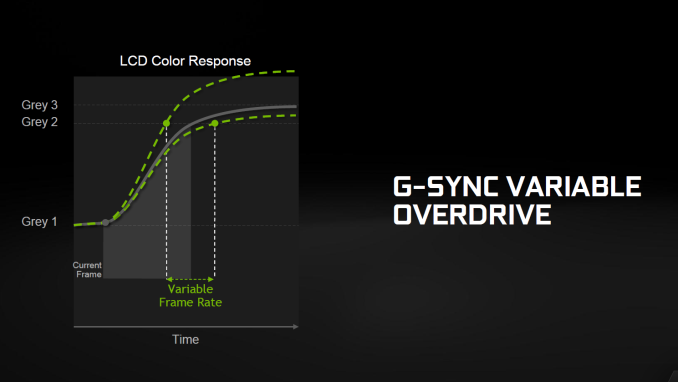
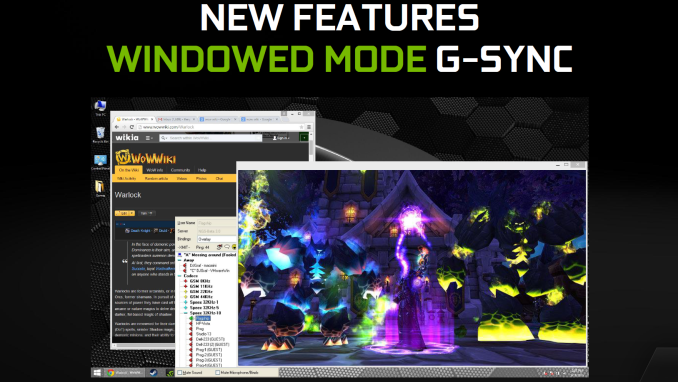
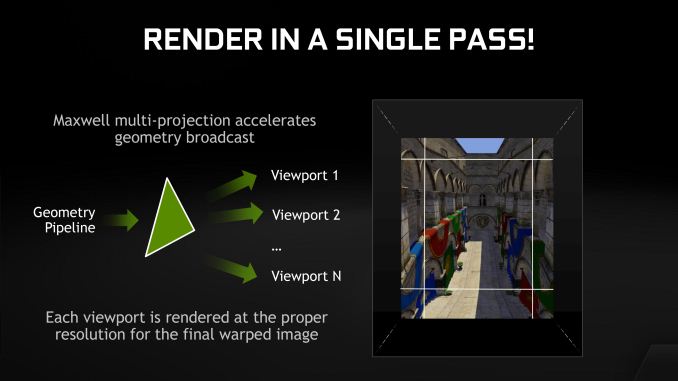
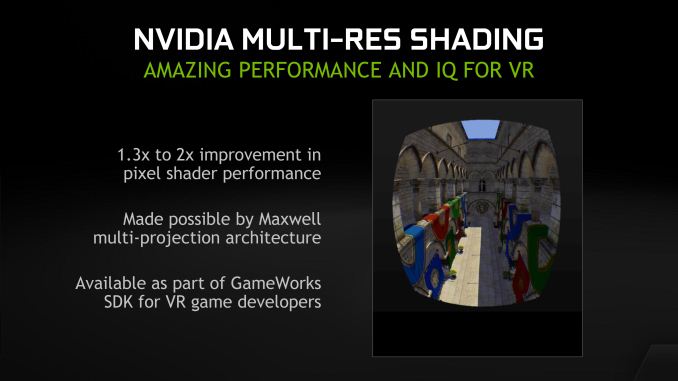
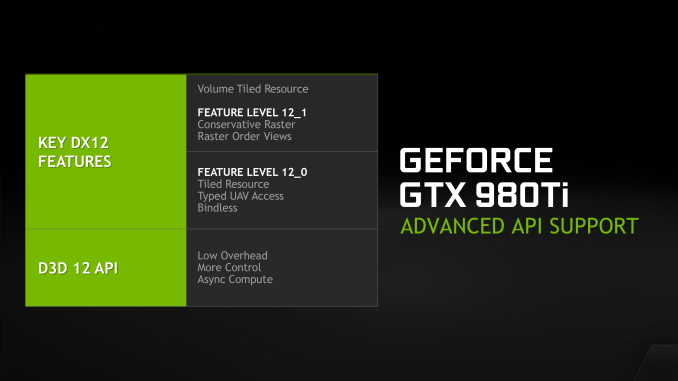








290 Comments
View All Comments
Laststop311 - Monday, June 1, 2015 - link
how is 6GB the minimum ram needed till finfet gpus? Even at 1440p with max settings no game requires 6GB of ram. Even if a game can use 6GB of ram the way some games are programmed they just use up extra ram if it is available but that used ram isn't crucial to the operation of the game. So it will show a high ram usage when in reality it can use way less and be fine.You are overly paranoid. 4GB of ram should be just fine to hold u off a year or 2 till finfet gpus comes out for 1440p res. If you are smart you will skip these and just wait for 2h 2016 where 14/16nm finfet gpu's are going to make a large leap in performance. That generation of gpu's should be able to be kept long term with good results. This is when you would want an 8GB card to keep it running smooth for a good 3-4 years, since you should get good lifespan with the first finfet gpu's.
chizow - Monday, June 1, 2015 - link
Again, spoken from the perspective of someone who doesn't have the requisite hardware to test or know the difference. I've had both a 980 and a Titan X, and there are without a doubt, games that run sluggishly as if you are moving through molasses as soon as you turn up bandwidth intensive settings, like MSAA, texture quality and stereo 3D and hit your VRAM limits even with the FRAPs meter saying you should be getting smooth frame rates.With Titan X, none of these problems and of course, VRAM shoots over the 4GB celing I was hitting before.
And why would I bother to keep running old cards that aren't good enough now and wait for FinFET cards that MIGHT be able to run for 3-4 years after that? I'll just upgrade to 14/16nm next year if the difference is big enough, it'll be a similar 18-24 month timeframe when I usually make my upgrades anyways. What am I supposed to do in this year while I wait for good enough GPUs? Not play any games? Deal with 2-3GB slow cards at 1440p? No thanks.
Refuge - Monday, June 1, 2015 - link
So you are saying I shouldn't be asking questions about something I'm spending my hard earned money on? Not a small sum of which at that?You sir should buy my car, it is a great deal, just don't ask me about it. Because that would be stupid!
Yojimbo - Monday, June 1, 2015 - link
He's not questioning your concern, he's questioning your criteria.Peichen - Sunday, May 31, 2015 - link
Why is the most popular mid-high card: GTX 970, not on the comparison list? It is exactly half the price as 980 Ti and it would be great to see if it is exactly 50% the speed and uses half the power as well.dragonsqrrl - Sunday, May 31, 2015 - link
It's definitely more than 50% the performance and power consumption, but yes it would've been nice to include in the charts.PEJUman - Monday, June 1, 2015 - link
Ryan's selection is not random. it seems he selects the likely upgrade candidates & nearest competitors. it's the same reasoning why there is no R9 290 here. most 970 and R9 290 owners probably know how to infer their card performance from the un-harversted versions (980 and 290x).Granted, it's odd to see 580 here and 970 will be more valuable technically.
mapesdhs - Wednesday, June 3, 2015 - link
Plus, most requests I've seen on forums have been for 970 SLI results rather than a 970 on its own, as 970 SLI is the more likely config to come anywhere a 980 Ti, assuming VRAM isn't an issue. Data for 970 SLI would thus show where in the various resolution/detail space one sees performance tail off because it needs more than 4GB.bloodypulp - Monday, June 1, 2015 - link
The 295X2 still crushes it. But blind Nvidia fanboys will claim it doesn't matter because it is either a) not a single GPU or b)AMD (and therefore sucks).PEJUman - Monday, June 1, 2015 - link
I owns 290 crossfire currently, previously a single 780 TI. Witcher 3 still sucks for my 290 CF, as well as the 295X2. so... depends on your game selections. I also have to spend more time customizing most of my games to get the optimal settings on my 290 CF than my 780TI.